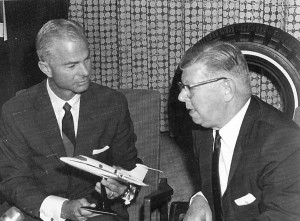 Charlie Gates is a man of constant motion, living his life in as energetic and vigorous a fashion as the frenetic manufacturing in the rubber plants that carried his name. He’s been involved in everything from belts to boots, but his highest calling turned out to be aviation. Just three years after the innovative jet started flying, a series of accidents and setbacks left Lear Jet with an uncertain future. Charles Gates’ belief in the new jet not only saved it, but his vision also took Lear Jet to unimagined heights with new product development and profitability.
Charlie Gates is a man of constant motion, living his life in as energetic and vigorous a fashion as the frenetic manufacturing in the rubber plants that carried his name. He’s been involved in everything from belts to boots, but his highest calling turned out to be aviation. Just three years after the innovative jet started flying, a series of accidents and setbacks left Lear Jet with an uncertain future. Charles Gates’ belief in the new jet not only saved it, but his vision also took Lear Jet to unimagined heights with new product development and profitability.
Born May 27, 1921, Gates was the fifth child—and first son—born to Charles Cassius and Hazel Gates. Charles C. Gates turned to manufacturing to support his new family. For an investment of $3,500, he became the owner of the Colorado Tire and Leather Company.
Although the company wasn’t as profitable as he had been led to believe, Gates kept his chin up. Advertising and new products ranging from horse halters to fan belts managed to lure customers, and in 1919, the business became the Gates Rubber Company.
After the Japanese bombed Pearl Harbor in December 1941, the nation once again found itself at war. Gates employees, which soon included many housewives, operated six-day, 48-hour weeks to produce rubber products for the home and war fronts. In 1961, the elder Gates, 83, died, leaving behind a specialized company in a highly competitive and volatile rubber business. After several attempts to diversify, the younger Gates concluded that aviation was the way to go.
Earlier, Gates, a pilot, had acquired a Beech Travel Air, in which to transport Gates Rubber executives, from Harry Combs. In 1966, he acquired the Combs FBO, renaming it Combs Gates. The following year, Gates acquired Roscoe Turner’s FBO. Although numbering only two at the time, the Combs Gates network of fixed base operations was born.
“I believed in corporate aircraft early,” said Gates. “We went through the slower twin and DC-3s, and the Fokker F-27, working up the line.”
In 1967, conversation between Combs and Gates turned to the Learjet. In April 1967, Gates acquired control of Lear Jet Industries.
“The Learjet had become synonymous with the corporate jet,” Gates said.
Lear Jet Industries Inc. became Gates Learjet Corporation and Gates served as chairman of the board.
In September 1987, after 20 years, Gates sold Gates Learjet Corporation. Today, Learjets are the backbone of Bombardier Aerospace, a world leader of business and commercial aircraft.











